
A mastodon is a member of the genus Mammut, which, strictly defined, was endemic to North America and lived from the late Miocene to the early Holocene. Mastodons belong to the order Proboscidea, the same order as elephants and mammoths. Mammut is the type genus of the extinct family Mammutidae, which diverged from the ancestors of modern elephants at least 27–25 million years ago, during the Oligocene.

Liquidambar, commonly called sweetgum, gum, redgum, satin-walnut, or American storax, is the only genus in the flowering plant family Altingiaceae and has 15 species. They were formerly often treated in Hamamelidaceae. They are native to southeast and east Asia, the eastern Mediterranean and eastern North America. They are decorative deciduous trees that are used in the wood industry and for ornamental purposes.

Desmans are diving insectivores of the tribe Desmanini in the mole family, Talpidae.

Microtus is a genus of voles found in North America, Europe and northern Asia. The genus name refers to the small ears of these animals. They are stout rodents with short ears, legs and tails. They eat green vegetation such as grasses and sedges in summer, and grains, seeds, root and bark at other times. The genus is also called "meadow voles".

The North American water vole or just water vole is the largest North American vole. It is found in the northwestern United States and southern parts of western Canada. This animal has been historically considered a member of genus Arvicola, but molecular evidence demonstrates that it is more closely related to North American Microtus species. Water voles are on the USDA Forest Service Region 2 sensitive species list because they maintain very small populations and there is high concern that their required habitat may be declining.
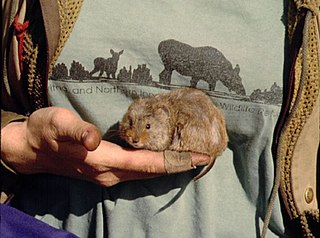
The taiga vole is a large vole found in northwestern North America, including Alaska and northwestern Canada. The name "taiga vole" comes from its living in the boreal taiga zone. It is also sometimes called the yellow-cheeked vole or chestnut-cheeked vole because of the rusty-yellow color on its face around its vibrisae (whiskers); The taiga voles derive their name from these features: "xantho" is Greek for yellow and "gnathus" is Greek for jaw. It is typically much larger than most other North American voles, especially those from the genus Microtus.

The genus Phenacomys is a group of North American voles. The genus name comes from the Greek for "imposter mouse."

The Pyrenean desman or Iberian desman is a small semiaquatic, globally threatened mammal related to moles and shrews, and, along with the Russian desman , is one of the two extant members of the tribe Desmanini. The species occurs in north and central parts of Spain and Portugal, French Pyrenees, and Andorra, but severe range contractions have been documented across its geographic distribution.

Chasmaporthetes, also known as hunting or running hyena, is an extinct genus of hyenas distributed in Eurasia, North America, and Africa during the Pliocene-Pleistocene epochs, living from 4.9 million to 780,000 years ago, existing for about 4.12 million years. The genus probably arose from Eurasian Miocene hyenas such as Thalassictis or Lycyaena, with C. borissiaki being the oldest known representative. The species C. ossifragus was the only hyena to cross the Bering land bridge into the Americas, and ranged over what is now Arizona and Mexico during Blancan and early Irvingtonian Land Mammal ages, between 5.0 and 1.5 million years ago.
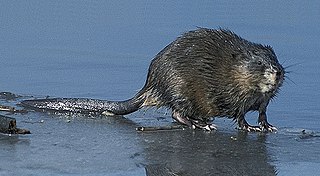
Ondatrini is a tribe of semiaquatic rodents in the family Arvicolinae. They are known as muskrats. They are related to voles and lemmings.

The California vole is a type of vole which lives throughout much of California and part of southwestern Oregon. It is also known as the "California meadow mouse", a misnomer as this species is a vole, not a mouse. It averages 172 mm (6.8 in) in length although this length varies greatly between subspecies.
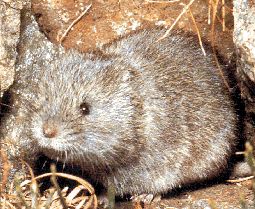
The European snow vole or snow vole is a species of rodent in the family Cricetidae. It has dense, pale grey fur and a pale-coloured tail and can reach about 14 cm (5.5 in) long, with a tail which is 7 cm (2.8 in) long.
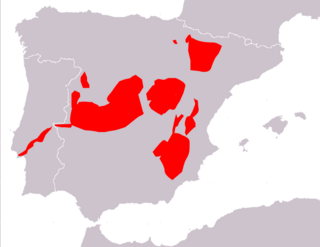
Cabrera's vole is a species of vole native to Spain and Portugal. It is named for Ángel Cabrera, a mammalogist then working at the Museo Nacional de Ciencias Naturales in Madrid. It is the only living member of the subgenus Iberomys, although two fossil species are also known, including M. brecciensis, the likely direct ancestor of the living species.
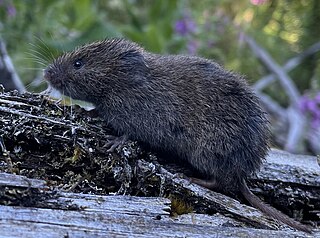
The creeping vole, sometimes known as the Oregon meadow mouse, is a small rodent in the family Cricetidae. Ranging across the Pacific Northwest of North America, it is found in forests, grasslands, woodlands, and chaparral environments. The small-tailed, furry, brownish-gray mammal was first described in the scientific literature in 1839, from a specimen collected near the mouth of the Columbia River. The smallest vole in its range, it weighs around 19 g. At birth, they weigh 1.6 g, are naked, pink, unable to open their eyes, and the ear flaps completely cover the ear openings. Although not always common throughout their range, there are no major concerns for their survival as a species.

Nothrotheriops is a genus of Pleistocene ground sloth found in North America, from what is now central Mexico to the southern United States. This genus of bear-sized xenarthran was related to the much larger, and far more famous Megatherium, although it has recently been placed in a different family, Nothrotheriidae. The best known species, N. shastensis, is also called the Shasta ground sloth.

Hesperotestudo is an extinct genus of tortoise native to North and Central America from the Early Miocene to the Late Pleistocene. Species of Hesperotestudo varied widely in size, with a large undescribed specimen from the Late Pleistocene of El Salvador reaching

Arvicolini is a tribe of voles in the subfamily Arvicolinae.

The Noisetier Cave, owing its popular name to the Hazel trees that grow in front of its entrance, is located in a mountainside 145 m (476 ft) atop the Vallée d'Aure in the Ardengost commune, Hautes-Pyrénées department in the region Occitania, Southern France. During systematic excavations since 1992 Middle Paleolithic stone tools and artifacts attributed to the Neanderthal Mousterian culture were discovered among numerous faunal remains.

Arago cave is a prehistoric site in the community of Tautavel, in the department of Pyrénées-Orientales. It is a large cavity overlooking a perennial stream called the Verdouble. Human remains attributed to the Tautavel Man and the lithic remnants of the Lower Paleolithic were discovered in the cave.
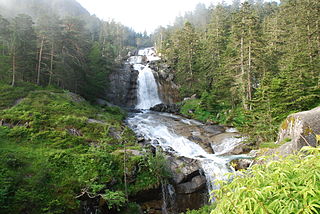
The Pyrenees conifer and mixed forests is a temperate broadleaf and mixed forests ecoregion in southwestern Europe. It extends along the Pyrenees mountains which run east and west along the border between France and Spain, and includes all Andorra. The ecoregion extends from the lower slopes of the Pyrenees to its highest peaks, which include Aneto, Posets, and Vignemale.




















